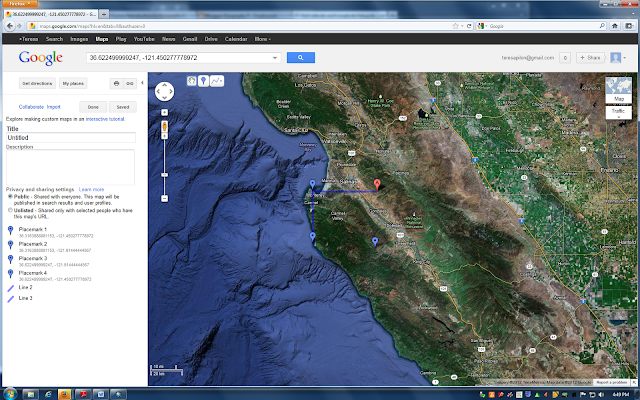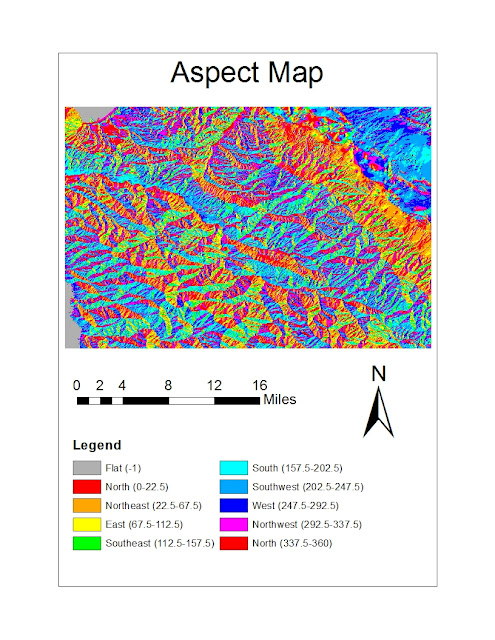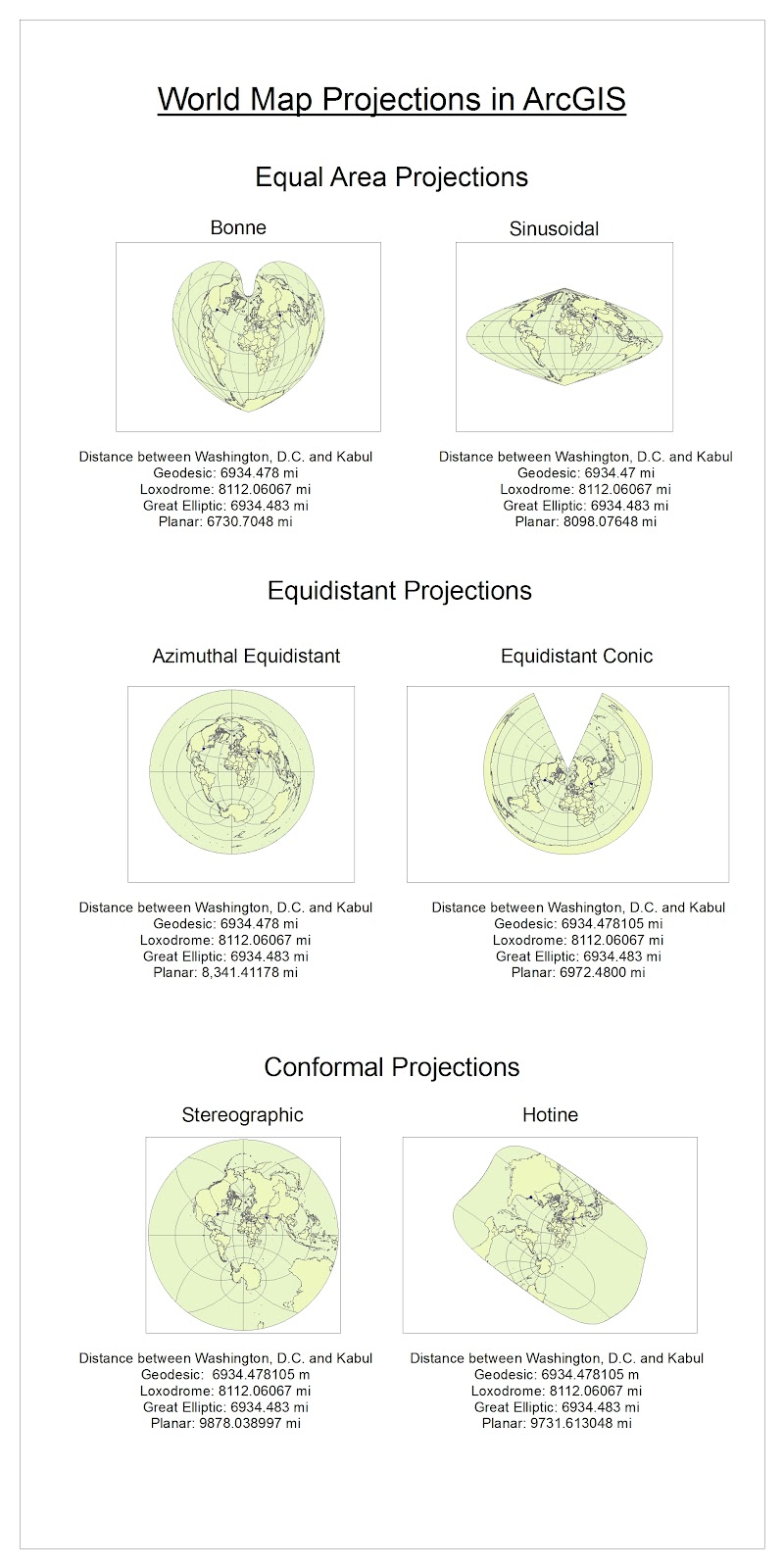Thursday, May 31, 2012
Thursday, May 24, 2012
Lab 6: DEMs in ArcGIS
This area is south of Monterrey Bay, directly south of the city of Salinas. It includes Toro Park, Laguna Seca Recreation Area, and the Carmel Valley. This area also includes part of Garrapata State Park; parts of the cities of Monterrey, Carmel, and Gonzales; and sections of the 101 and 1 Freeways. The area is about 21 miles North-South by about 26 miles East-West as very roughly approximated on GoogleMaps. The land contained by this area is utilized for a myriad of uses, including urban and suburban development, a military housing complex, a presidio, recreation areas, golf courses, parks, agriculture, an airport, and roads. The top left corner includes an area of Monterrey Bay and the bottom left corner includes a piece of the Pacific Ocean. The topography varies greatly across the area with hills and valleys.
The approximate location of this area is shown on this GoogleMap image. The four points represent the four corners of the area's extent given by the DEM model.

The extent information in decimal degrees of this area is described in the DEM model as:
Top: 36.622499999247
Left: -121.91444444567, Right: - 121.450277778972
Bottom: 36.3163888881153
This area is defined by the Geographic Coordinate System North American 1983.

The approximate location of this area is shown on this GoogleMap image. The four points represent the four corners of the area's extent given by the DEM model.

The extent information in decimal degrees of this area is described in the DEM model as:
Top: 36.622499999247
Left: -121.91444444567, Right: - 121.450277778972
Bottom: 36.3163888881153
This area is defined by the Geographic Coordinate System North American 1983.

3D Image
Friday, May 18, 2012
Lab 5: Projections in ArcGIS
The variety of map projections and range of layouts and types within each projection category provide several opportunities for how to present geographic information. For example, both the Bonne and Sinusoidal projections are equal are projections, meaning that they preserve the relative areas of continents and oceans on their maps. Even so, the two projections appear very different from one another so could be preferred for different presentations of information or other uses. The sheer number of available map projections mean that users have several options for selecting a projection that best fits a specific use.
This same extent of options, however, can make choosing and understanding map projections difficult. Certain map projections are surely better suited for particular purposes, but it can be hard to decide which map projection is most accurate or should be widely used. The contortion of the graticule on some projections could make locating a point or determining distance especially difficult.
In addition to complicating decisions about map usages, map projections can make thinking about the real world confusing. Knowing which distances are accurate can be difficult, especially with limited knowledge of map projections or measurement types. It is easier to understand why the Planar measurement changes projection to projection, but difficult to know when the Planar measurement is an accurate representation of distance. Because the Geodesic and Great Elliptic measurements remained constant throughout the six projections and similar to one another, it seems reasonable to assume that the distance between Washington, D.C. and Kabul is indeed about 6,934.48 miles. The Loxodromic measurement also remained constant across all the projections though, but gave a distance of 8,112.06 miles between the two cities. The difference between the Loxodromic and Geodesic/Great Elliptic measurements is so great that it definitely can cause confusion about map projection measurements and possibly even uncertainty about the actual distance separating Washington, D.C. and Kabul.
Because of these potential pitfalls, users must be especially when choosing and reading world maps. Both map makers and users should be aware of the projection type, preserved properties, and contorted properties in order to read the map correctly. Only being informed of the variety and staying alert to potential challenges, can we most effectively and truthfully convey and understand geographic information on map projections. Once these pitfalls are understood and users cautioned, however, the range of available map projections can be utilized to most accurately and easily express geography.
Friday, May 11, 2012
Week 4-6 Lab
ArcGIS has both many advantages and disadvantages. Its huge
capacity and attention to detail make it incredibly applicable and useful, but
this same complexity can limit its audience.
Regardless of these pitfalls though, ArcGIS’s storage capacity and the
number of different things its users can look of and express with the software
is amazing. I was in awe of how much
data and different types of data are available through the software, and as I worked
through the tutorial I was excited and a little intimidated about using the
software for a variety of applications.
In addition to providing so much information, ArcGIS lets that information be presented in a clear and professional way. The editor tool bar and ability to set colors and positions in every map, graph, and poster let the data appear clean and easy to read. By editing and organizing the information, ArcGIS presentations can be accessible and understandable to individuals of varying knowledge and experience who can benefit the information.
Although ArcGIS is incredibly useful and informative; in some cases it can only benefit a certain group of people. Both creating and reading ArcGIS maps and all of the information stored in the entities’ attributes require a significant level of computer literacy. Individuals without high computer skills cannot take full advantage of ArcGIS’s expansive and intricate information and capabilities. ArcGIS probably needs to be computer intensive to be able to do everything it does, but even so, it excludes a group of people who could potentially have high geospatial or social knowledge and insight that could greatly benefit society when applied to GIS technology.
ArcGIS software is incredibly expensive and constantly being updated. The high cost of the software further excludes individuals who may have useful geographic knowledge and/or computer skills but are unable to afford ArcGIS. ArcGIS’s price in combination with its prevalence in the GIS field to some extent make GIS an elite field, requiring individuals to have experience with the expensive program and companies to buy the software. The fact that ArcGIS constantly releases new versions requires that individuals and companies must continue purchasing and learning to use the software.
In addition to providing so much information, ArcGIS lets that information be presented in a clear and professional way. The editor tool bar and ability to set colors and positions in every map, graph, and poster let the data appear clean and easy to read. By editing and organizing the information, ArcGIS presentations can be accessible and understandable to individuals of varying knowledge and experience who can benefit the information.
Although ArcGIS is incredibly useful and informative; in some cases it can only benefit a certain group of people. Both creating and reading ArcGIS maps and all of the information stored in the entities’ attributes require a significant level of computer literacy. Individuals without high computer skills cannot take full advantage of ArcGIS’s expansive and intricate information and capabilities. ArcGIS probably needs to be computer intensive to be able to do everything it does, but even so, it excludes a group of people who could potentially have high geospatial or social knowledge and insight that could greatly benefit society when applied to GIS technology.
ArcGIS software is incredibly expensive and constantly being updated. The high cost of the software further excludes individuals who may have useful geographic knowledge and/or computer skills but are unable to afford ArcGIS. ArcGIS’s price in combination with its prevalence in the GIS field to some extent make GIS an elite field, requiring individuals to have experience with the expensive program and companies to buy the software. The fact that ArcGIS constantly releases new versions requires that individuals and companies must continue purchasing and learning to use the software.
Subscribe to:
Comments (Atom)







